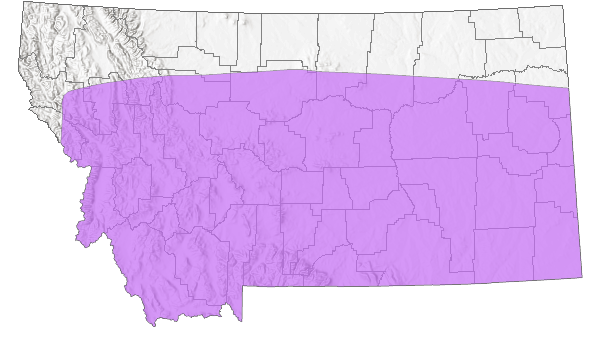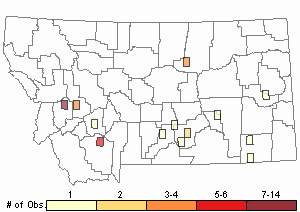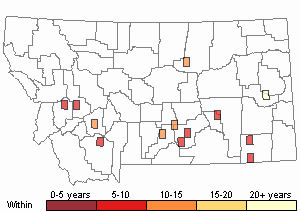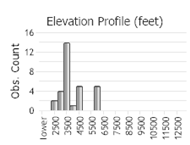View in other NatureServe Network Field Guides
NatureServe
Montana
Utah
Wyoming
Idaho
Wisconsin
British Columbia
South Carolina
Yukon
California
New York
Paiute Dancer - Argia alberta
State Rank Reason (see State Rank above)
The Paiute Dancer damselfly is currently listed as an "S2S3" species of potential concern in Montana because they are potentially at risk because of limited and/or declining numbers, range and/or habitat, even though it may be abundant in some areas.
General Description
The small size (hindwing 16-20 mm, length of abdomen 22mm), predominantly dark coloration of the abdominal segments, and elongate, linear cerci distinguish this species from any other in the U.S. (Garrison, 1994; Kennedy, 1918).
Male -- Color: Labrum pale blue, the remainder of the face and head blue with an olive or, in some dried material, a violet cast. Under surface of head yellowish gray with a small black spot on each side of the occipital foramen. Clypeus edged with black. A wide bar through the paired ocelli and a broad, black stripe behind each postoccular area. Eyes dark blue, paler below. Prothorax black dorsally with a bluish spot on each side. Mesothoroax and metathorax dull blue (violet or brown in dried material) darker and duller on the dorsal surface and grayish on the sides. Middorsal stripe occupying one-third of the area between the humeral sutures. Humeral stripe half as wide as the mid-dorsal, it's upper third forked. A black line on the second lateral suture 1mm. wide. Pterostigmata brown subtended by one cell. Legs pale with blue on base of femora, broadly marked with black on the dorsal and anterior surfaces of the tibiae. Tarsi black. Abdomen with seg. 1-3 dull blue becoming duller or brownish on the lower sides. Seg. 1 with a baso-dorsal black spot. Seg. 2 with a narrow apical band and a lateral stripe black. Segs. 4-7 with the apical third and the dorsum black except a narrow basal band blue, the sides bluish or brownish. Segs 8-10 pure, pale blue, the lower edges more or less blotched with black. Superior appendages twice as long as wide when viewed from above, slender in profile. A prominent, internal, apical hook directed ventrad. Inferior appendages bifid, the lower ramus round or bluntly triangular directed caudad, superior lobe directed dorsad and terminating in an acute point.
Female.-- Color as in male but with the blue of the head and thorax paler. Eyes gray bluish above. Humeral stripe but half as wide as in the male, it's branches linear. Legs marked as in male but the black on the femora reduced somewhat. Abdomen brown with a narrow apical band on Segs. 2-6. Segs. 2-6 with an apical dorsal spot, a lateral stripe and an oblique spot on the lower apical angle of the side. Segs. 8-9 with dorsolateral stripe. Seg. 10 pale. In some females Seg. 6 is colored like 7. Mesostigmal laminae with no special modifications (Kennedy, 1918).
Species Range
Montana Range
Range Descriptions

 Native
Native
Range Comments
Primarily a Great Basin species (Garrison, 1994). Records from Colorado, Utah, southern Oregon, Idaho, Montana, Nevada, western Kansas, Nebraska, south Dakota, western Oklahoma, northern Arizona, northern New Mexico, and California. Currently, Paiute Dancers are only known from warm springs in western and central areas of the state (Miller and Gustafson 1996).
Observations in Montana Natural Heritage Program Database
Number of Observations: 38
(Click on the following maps and charts to see full sized version)
Map Help and Descriptions
Relative Density

Recency



 (Observations spanning multiple months or years are excluded from time charts)
(Observations spanning multiple months or years are excluded from time charts)
Habitat
Paiute Dancers are associated with warm or hot-springs, as well as spring-fed marshes and sandy streams that flow from the springs. Vegetation is abundant and mostly sedges (Westfall and May 1996; Paulson 2009).
Ecological Systems Associated with this Species
- Details on Creation and Suggested Uses and Limitations
How Associations Were Made
We associated the use and habitat quality (common or occasional) of each of the 82 ecological systems mapped in Montana for
vertebrate animal species that regularly breed, overwinter, or migrate through the state by:
- Using personal observations and reviewing literature that summarize the breeding, overwintering, or migratory habitat requirements of each species (Dobkin 1992, Hart et al. 1998, Hutto and Young 1999, Maxell 2000, Foresman 2012, Adams 2003, and Werner et al. 2004);
- Evaluating structural characteristics and distribution of each ecological system relative to the species' range and habitat requirements;
- Examining the observation records for each species in the state-wide point observation database associated with each ecological system;
- Calculating the percentage of observations associated with each ecological system relative to the percent of Montana covered by each ecological system to get a measure of "observations versus availability of habitat".
Species that breed in Montana were only evaluated for breeding habitat use, species that only overwinter in Montana were only evaluated for overwintering habitat use, and species that only migrate through Montana were only evaluated for migratory habitat use.
In general, species were listed as associated with an ecological system if structural characteristics of used habitat documented in the literature were present in the ecological system or large numbers of point observations were associated with the ecological system.
However, species were not listed as associated with an ecological system if there was no support in the literature for use of structural characteristics in an ecological system,
even if point observations were associated with that system.
Common versus occasional association with an ecological system was assigned based on the degree to which the structural characteristics of an ecological system matched the preferred structural habitat characteristics for each species as represented in scientific literature.
The percentage of observations associated with each ecological system relative to the percent of Montana covered by each ecological system was also used to guide assignment of common versus occasional association.
If you have any questions or comments on species associations with ecological systems, please contact the Montana Natural Heritage Program's Senior Zoologist.
Suggested Uses and Limitations
Species associations with ecological systems should be used to generate potential lists of species that may occupy broader landscapes for the purposes of landscape-level planning.
These potential lists of species should not be used in place of documented occurrences of species (this information can be requested at:
mtnhp.org/requests) or systematic surveys for species and evaluations of habitat at a local site level by trained biologists.
Users of this information should be aware that the land cover data used to generate species associations is based on imagery from the late 1990s and early 2000s and was only intended to be used at broader landscape scales.
Land cover mapping accuracy is particularly problematic when the systems occur as small patches or where the land cover types have been altered over the past decade.
Thus, particular caution should be used when using the associations in assessments of smaller areas (e.g., evaluations of public land survey sections).
Finally, although a species may be associated with a particular ecological system within its known geographic range, portions of that ecological system may occur outside of the species' known geographic range.
Literature Cited
- Adams, R.A. 2003. Bats of the Rocky Mountain West; natural history, ecology, and conservation. Boulder, CO: University Press of Colorado. 289 p.
- Dobkin, D. S. 1992. Neotropical migrant land birds in the Northern Rockies and Great Plains. USDA Forest Service, Northern Region. Publication No. R1-93-34. Missoula, MT.
- Foresman, K.R. 2012. Mammals of Montana. Second edition. Mountain Press Publishing, Missoula, Montana. 429 pp.
- Hart, M.M., W.A. Williams, P.C. Thornton, K.P. McLaughlin, C.M. Tobalske, B.A. Maxell, D.P. Hendricks, C.R. Peterson, and R.L. Redmond. 1998. Montana atlas of terrestrial vertebrates. Montana Cooperative Wildlife Research Unit, University of Montana, Missoula, MT. 1302 p.
- Hutto, R.L. and J.S. Young. 1999. Habitat relationships of landbirds in the Northern Region, USDA Forest Service, Rocky Mountain Research Station RMRS-GTR-32. 72 p.
- Maxell, B.A. 2000. Management of Montana's amphibians: a review of factors that may present a risk to population viability and accounts on the identification, distribution, taxonomy, habitat use, natural history, and the status and conservation of individual species. Report to U.S. Forest Service Region 1. Missoula, MT: Wildlife Biology Program, University of Montana. 161 p.
- Werner, J.K., B.A. Maxell, P. Hendricks, and D. Flath. 2004. Amphibians and reptiles of Montana. Missoula, MT: Mountain Press Publishing Company. 262 p.
Food Habits
Larvae feed on a wide variety of aquatic insects, such as mosquito larvae, other aquatic fly larvae, mayfly larvae, and freshwater shrimp.
Adult- This damselfly will eat almost any soft-bodied flying insect including mosquitoes, flies, small moths, mayflies, and flying ants or termites.
Ecology
Often associated with Argia vivida (Miller and Gustafson 1996).
Reproductive Characteristics
Male Paiute Dancers can be found searching for females in and at the edge of vegetation, as well as at waterline of open sedge areas (Paulson 2009). Oviposition likely to occur in tandem which is common for this genus.
References
- Literature Cited AboveLegend:
 View Online Publication
View Online Publication Garrison, R.W. 1994. A revision of the New World genus Erpetogomphus Hagen in Selys (Odonata: Gomphidae). Tijdschrift voor Entomologie 137(2): 173-269.
Garrison, R.W. 1994. A revision of the New World genus Erpetogomphus Hagen in Selys (Odonata: Gomphidae). Tijdschrift voor Entomologie 137(2): 173-269. Kennedy, C.H. 1918. New species of Odonata from the southwestern United States. Part I. Three new Argias. Canad. Entomol. vol. 50, no. 8, 256-261.
Kennedy, C.H. 1918. New species of Odonata from the southwestern United States. Part I. Three new Argias. Canad. Entomol. vol. 50, no. 8, 256-261. Miller, K.B. and D.L. Gustafson. 1996. Distribution records of the Odonata of Montana. Bulletin of American Odonatology 3(4):75-88.
Miller, K.B. and D.L. Gustafson. 1996. Distribution records of the Odonata of Montana. Bulletin of American Odonatology 3(4):75-88. Westfall, M.J., Jr. and M.L. May. 1996. Damselflies of North America. Scientific Publishers, Gainesville, Florida. 649 pp.
Westfall, M.J., Jr. and M.L. May. 1996. Damselflies of North America. Scientific Publishers, Gainesville, Florida. 649 pp.
- Additional ReferencesLegend:
 View Online Publication
View Online Publication
Do you know of a citation we're missing? Acorn, J. 2004. Damselflies of Alberta: flying neon toothpicks in grass. Edmonton, Alberta: University of Alberta Press. 156 pp.
Acorn, J. 2004. Damselflies of Alberta: flying neon toothpicks in grass. Edmonton, Alberta: University of Alberta Press. 156 pp. Dunkle, S.W. 2000. Dragonflies through binoculars: A field guide to dragonflies of North America. New York, NY. Oxford University Press. 266 pp.
Dunkle, S.W. 2000. Dragonflies through binoculars: A field guide to dragonflies of North America. New York, NY. Oxford University Press. 266 pp. Paulson, D.R. 2009. Dragonflies and Damselflies of the West. Princeton University Press, Princeton. 535 pp.
Paulson, D.R. 2009. Dragonflies and Damselflies of the West. Princeton University Press, Princeton. 535 pp.
- Web Search Engines for Articles on "Paiute Dancer"
- Additional Sources of Information Related to "Insects"





